Get Complete Project Material File(s) Now! »
density (SD)
A general PCA was performed with the 15 measured traits (Fig. 7). The main plane of the PCA (F1 × F2) explained 56.9% of the overall variability, with 29.1% for F1 and 27.8% for F2 axis. F1 was mostly correlated with traits defining water use efficiency at different scales like 13Css, 13Clb, A/gs, Ci/Ca, A, whole-plant TE that were also tightly correlated to BM and SD. The second axis was related to water use and oxygen isotope composition, with correlations to TLA and gs.
Along the F1 axis A/gs, A, whole-plant TE and SD were positively inter-correlated and negatively correlated to 13Css, 13Clb and Ci/Ca. Along the F2 axis WU scaled positively with TLA and gs and negatively with 18Olb. (see Table 3 for r- values of Pearson’s correlation coefficients between traits). There was a clear grouping among individuals in the F1 × F2 planes with some overlaps between genotypes. Pannonia and I45/51 were clearly discriminated along axis 2, the latter being much less productive and efficient with respect to water use than the former. Axis 1 was dominated by total leaf area and did less clearly discriminate the genotypes due to some variability in size within genotypes. This in particular explains why we were unable to detect any genotype difference in 18Olb or 18Olw despite large differences among individuals and a significant correlation with water use and stomatal conductance at individual level.
Rasheed et al. 2012 13C as an estimator of whole-plant transpiration efficiency in poplar
In this study the complex trait “transpiration efficiency” (TE) was recorded at whole-plant level over a month, and at leaf level during a day with gas exchange measurements and 13C composition of soluble sugars. We used also 13C composition of bulk leaf matter as an indicator integrating leaf life span. The different approaches provided convergent estimates for genotype differences in TE.
Discrimination against 13C from the air to bulk leaf matter ( 13Clb) or to soluble sugars ( 13Css)
The tight correlation observed between 13Clb and 13Css at individual as well as at genotype level, confirms that the differences in the 13C signal recorded in soluble sugars that display a rapid turn-over, were still visible in the bulk leaf matter built over several weeks. This is due to the stable conditions that prevailed in the climate chambers since the start of leaf expansion. It also confirms that post-photosynthetic 13C discrimination had similar effects in all genotypes and did not modify the ranking of genotypes. A similar close relationship was described in a range of oak genotypes (Roussel et al. 2009a). Leaves were sampled from fast growing and very actively photosynthesizing poplar cuttings at the end of a 16 h illumination phase. They contained a large amount of soluble sugars (around 16% total dry matter), and the extracts displayed a high purity indicated by a very low N content (no contamination by amino acids) and a C content close to that of sucrose or of a mix of carbohydrates. In the forthcoming discussion we will focus on 13Css as a potential index for intrinsic TE, as it is expected to closely reflect discrimination during photosynthesis.
TE at leaf level: correlation of 13Css with A/gs
Rasheed et al. 2012 13C as an estimator of whole-plant transpiration efficiency in poplar The genotype means of 13Css were negatively correlated to mean diurnal A/gs over the whole illumination phase. In this respect, our data confirm that 13Css is a relevant indicator for genetic differences in A/gs as predicted by the model of Farquhar, Ehleringer & Hubick (1989), on-line with numerous earlier results (Brugnoli et al. 1988 for poplar).
To our surprise, 13Css was larger than 13Clb while bulk leaf matter is usually depleted in 13C with respect to carbohydrates, due to the presence of lipids and lignins (Bowling, Pataki & Randerson 2008; Monti et al. 2006). Such was the case for leaves of Fagus sylvatica (Gavrichkova et al. 2011) or of Quercus robur (Roussel et al. 2009a). We are not aware of any published result similar to ours. Several hypotheses may explain this discrepancy:
(i) a contribution to leaf structure of C stored before the transfer to the stable conditions of the climate chamber. This hypothesis is unlikely, as the leaves did expand after the transfer to the climate chamber, and as the biomass gain during the experiment was 9 times the initial biomass; the contribution of « old » C to the construction of new leaves was probably very minor;
(ii) diurnal changes have been recorded several times in 13Css (for instance, Gavrichkova et al. 2011) and as a consequence in the 13C signature of respired CO2 (see Werner & Gessler 2011 for a synthesis). Such changes may partly be due to changes in the environment (irradiance, temperature, VPD), which did not occur here. They may be due also to switches between respiratory substrates with different isotopic signatures. Such switches mainly occur during day-night transitions and are associated for instance to post-illumination respiratory bursts (Gessler et al. 2009) and are unlikely to impact 13Css recorded at the end of an illumination period;
(iii) the isotopic fractionation by aldolase results in a ~3-4 ‰ enrichment of the C-3 72
Rasheed et al. 2012 13C as an estimator of whole-plant transpiration efficiency in poplar and C-4 atoms of fructose in the chloroplasts (Gleixner & Schmidt 1997), and in a small but significant enrichment for starch accumulated in chloroplasts, while in the meanwhile, glucose and sucrose in the cytosol and the vacuole are slightly depleted (Brugnoli et al. 1988; Badeck et al. 2005; Bowling, Pataki & Randerson 2008). This depletion remains visible in the sucrose exported to the phloem. This is no longer true during night, when the stored starch is hydrolysed into 13C enriched sucrose.
The third hypothesis fits best with our situation as soluble sugars were sampled at the end of 16h illumination, with permanently high photosynthesis, and a large starch accumulation during the day (see Brugnoli et al. 1988 for an illustration of starch dynamics in poplar). This is likely to result in a depletion of soluble sugars with respect to the primary photosynthesis products (i.e., 3PGA), while leaf bulk matter contains large amounts of slightly enriched starch.
The tight and linear correlation between Ci/Ca and 13Css, paralleled the predictions of the simple form of the discrimination model of Farquhar & Richards (1984). The negative offset of 0.9 to 1.6‰, depending on the genotype, is partly due to the occurrence of a finite conductance to CO2 transfer in the mesophyll, gm (Evans & Von Caemmerer 1996; Evans et al. 2009; Flexas et al. 2012): this offset is the basis for indirect estimates of gm.
There are a few small uncertainties around our estimates of 13Css due for instance to our estimates of 13C in the chamber atmosphere. We used a mean value computed from records over several days. 13C in the atmosphere of the chamber may have undergone diurnal cycles due to the production of depleted CO2 over night, and photosynthesis during the day, resulting in an increase of 13CO2 in the air. As photosynthesis rates remained stable during the day, the use of a mean value of 13C in the atmosphere probably minimized this artefact.
There are still a number of uncertainties around the 13C discrimination model (Douthe et al. 2012; Farquhar & Cernusak 2012). In particular, the values of parameter “b” vary between 27 and 30‰ in the literature (Warren 2006; Douthe et al. 2012). In our case, the use of a value of 30‰ instead of 27‰ would have amplified the offset. We therefore avoided a direct computation of gm from our data set. Nevertheless, we may safely conclude that: (i) the different genotypes displayed as expected finite albeit probably large values of gm and (ii) gm
probably differed significantly among genotypes, with smaller values (i.e., larger offsets) for Agathe F and I45/51 with respect to the others. Nevertheless, these differences had only little impact on the ranking of the different genotypes as shown in Fig. 3.
Table of contents :
1. INTRODUCTION
1.1. Genus Populus:
1.2. Poplar hybrids
1.3. Poplar cultivation
1.4. Problematic and thesis objectives
2. STATE OF THE ART
2.1. Water use efficiency at different integration scales
2.1.1 At leaf level:
2.1.2 At whole plant level:
2.2. 13C discrimination as an estimator of intrinsic transpiration efficiency
2.3. Other sources of variation in 13C signals: isotopic signature of different organic compounds
2.4. Use of oxygen isotopes as estimator of stomatal conductance
2.5. 18O enrichment in the leaf
2.5.1. 18O enrichment of leaf water at the sites of evaporation
2.5.2. 18O enrichment of leaf organic matter
2.6. Dual isotopic approach (13C and 18O)
2.7. Age effect and potential causes
2.8. Sampling strategies to study age effect
2.9. Common problems in tree ring isotopic study
2.9.1. Choice of a wood component for isotopic analysis
2.9.2. Correcting chronology for trends in atmospheric 13C
Transition
CHAPTER 1: Genotype differences in 13C discrimination between atmosphere and leaf matter match differences in transpiration efficiency at leaf and whole-plant levels in hybrid Populus deltoides !
CHAPTER 2: Vapour pressure deficit during growth does not affect the ranking of Populus nigra
genotypes for transpiration efficiency at leaf as well as at whole tree level
CHAPTER 3: Time course of !13C in poplar wood: genotype ranking remains stable over the life cycle in plantations despite differences between cellulose and bulk-wood
CHAPTER 4: Age related trend in !13C does affect the genotypic ranking in 3 Populus ! euramericana genotypes: A synchronic approach.
GENERAL DISCUSSION AND CONCLUSION






